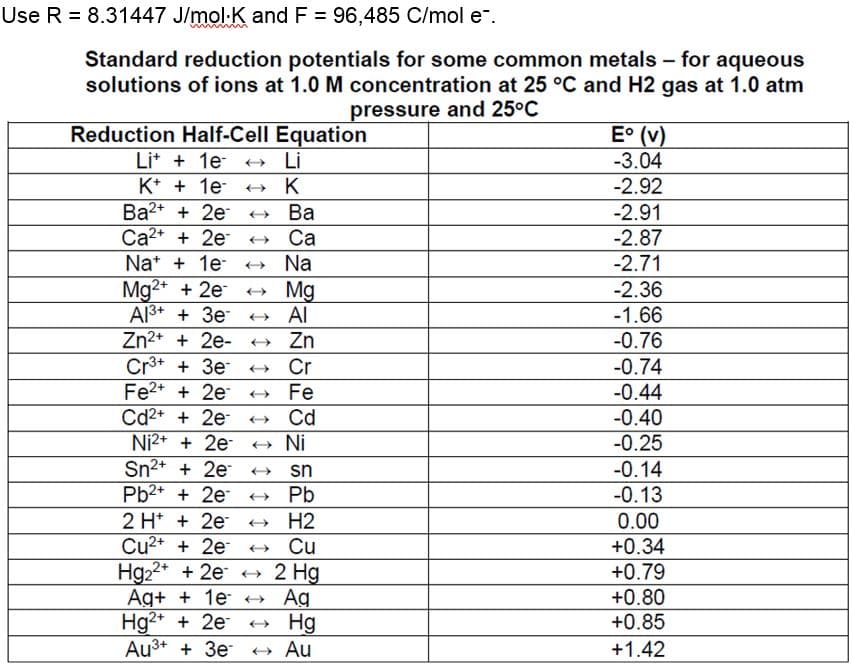An electrochemical cell is given with a cell reaction of Pb²⁺ + Cd → Pb + Cd²⁺ at 25°C with ion concentrations of [Cd²⁺] = 2 M, and [Pb²⁺] = 1.49×10⁻⁹ M. Used the photo as a reference. 1. What can be said of the reaction at the specified concentration of ions? 2. What is the equilibrium constant for the reaction?
An electrochemical cell is given with a cell reaction of Pb²⁺ + Cd → Pb + Cd²⁺ at 25°C with ion concentrations of [Cd²⁺] = 2 M, and [Pb²⁺] = 1.49×10⁻⁹ M. Used the photo as a reference. 1. What can be said of the reaction at the specified concentration of ions? 2. What is the equilibrium constant for the reaction?
Chemistry: An Atoms First Approach
2nd Edition
ISBN:9781305079243
Author:Steven S. Zumdahl, Susan A. Zumdahl
Publisher:Steven S. Zumdahl, Susan A. Zumdahl
Chapter17: Electrochemistry
Section: Chapter Questions
Problem 135CWP: Consider a galvanic cell based on the following half-reactions: a. What is the expected cell...
Related questions
Question
An
1. What can be said of the reaction at the specified concentration of ions?
2. What is the equilibrium constant for the reaction?

Transcribed Image Text:Use R = 8.31447 J/mol K and F = 96,485 C/mol e-.
Standard reduction potentials for some common metals - for aqueous
solutions of ions at 1.0 M concentration at 25 °C and H2 gas at 1.0 atm
pressure and 25°C
Reduction Half-Cell Equation
Li+ + 1e →→→ Li
K+ + 1e-
→ K
Ba2+ + 2e → Ba
Ca2+ + 2e → Ca
Na + 1e O Na
Mg2+ + 2e
→→ Mg
Al3+ + 3e → Al
Zn2+ + 2e- → Zn
Cr³+ + 3e → Cr
Fe2+ + 2e
→ Fe
Cd²+ + 2e-
Ni2+ + 2e
Sn²+ + 2e
sn
Pb2+ + 2e → Pb
→ Cd
→ Ni
2 H+ + 2e → H2
Cu2+ + 2e
→ Cu
Hg2+ + 2e → 2 Hg
Ag+ +1e
Ag
Hg2+ + 2e →→ Hg
Au³+ + 3e → Au
E° (v)
-3.04
-2.92
-2.91
-2.87
-2.71
-2.36
-1.66
-0.76
-0.74
-0.44
-0.40
-0.25
-0.14
-0.13
0.00
+0.34
+0.79
+0.80
+0.85
+1.42
Expert Solution
This question has been solved!
Explore an expertly crafted, step-by-step solution for a thorough understanding of key concepts.
Step by step
Solved in 2 steps with 1 images

Knowledge Booster
Learn more about
Need a deep-dive on the concept behind this application? Look no further. Learn more about this topic, chemistry and related others by exploring similar questions and additional content below.Recommended textbooks for you

Chemistry: An Atoms First Approach
Chemistry
ISBN:
9781305079243
Author:
Steven S. Zumdahl, Susan A. Zumdahl
Publisher:
Cengage Learning

Chemistry
Chemistry
ISBN:
9781305957404
Author:
Steven S. Zumdahl, Susan A. Zumdahl, Donald J. DeCoste
Publisher:
Cengage Learning


Chemistry: An Atoms First Approach
Chemistry
ISBN:
9781305079243
Author:
Steven S. Zumdahl, Susan A. Zumdahl
Publisher:
Cengage Learning

Chemistry
Chemistry
ISBN:
9781305957404
Author:
Steven S. Zumdahl, Susan A. Zumdahl, Donald J. DeCoste
Publisher:
Cengage Learning


Chemistry: The Molecular Science
Chemistry
ISBN:
9781285199047
Author:
John W. Moore, Conrad L. Stanitski
Publisher:
Cengage Learning

Chemistry: Principles and Practice
Chemistry
ISBN:
9780534420123
Author:
Daniel L. Reger, Scott R. Goode, David W. Ball, Edward Mercer
Publisher:
Cengage Learning

Chemistry: Principles and Reactions
Chemistry
ISBN:
9781305079373
Author:
William L. Masterton, Cecile N. Hurley
Publisher:
Cengage Learning